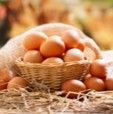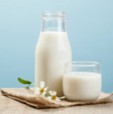Microalgae as Animal Feed
Microalgae can be the next alternative source for animal and aquatic feed production in an environmentally sustainable and nutritionally beneficial manner. These microorganisms can be produced on a large scale using photobioreactors and open ponds, and then harvested and processed to produce functional feed supplements for different animals such as poultry, pigs, sheep, and fish.
Microalgae Feed Supplement to Improve Egg Quality

Microalgae are alternative raw materials for essential omega-3 fatty acids (omega-3 FAs) to enhance the nutritional value of eggs for human consumption. The abundance of omega -3 FAs in eggs varies with the age and breed of the chicken and the digestibility of the microalgae. Eggs from hens fed with an algal mix rich in omega -3 FAs contained more beneficial fatty acids than eggs produced with conventional feed. In feed trials, it is demonstrated that the assimilation efficiency of DHA from microalgae to eggs is 42.6% when hens are provided with a 2.4% algal mix. The eggs of hens fed with algal feed have a 6-fold increase in DHA content compared to control eggs.
Microalgae to Improve Meat Quality
Microalgae are photosynthetic microorganisms that consume atmospheric carbon dioxide and light energy to produce a variety of proteins, carbohydrates, and lipids, as well as trace elements including minerals, vitamins, polyphenols, flavonoids, and carotenoids. Notably, lipoproteins, sterols, and alkaloids are molecules with health benefits such as boosting the immune system, which will ultimately reduce the use of antibiotics in livestock farming.

Livestock Farming
Recently, it has been found that the use of microalgae for pigs, such as Schizochytrium sp., can increase the content of omega-3 fatty acids in their meat and cause changes in the phenotypic appearance and function of skeletal muscle.

Poultry Farming
Supplementation of poultry feed with fresh liquid algae at a concentration of 1% will improve weight gain, immune characteristics, and lactic acid bacteria production in the gut microbiota of broilers.

Fish Farming
In addition, one study found that the whole-body omega-3 long-chain polyunsaturated fatty acid (n-3 LC-PUFA) content of fish from Rosamin can be increased when dry algae meal derived from Ulva ohnoi and Entomoneis spp. is added to 5.0% level.
Microalgae to Improve Milk Production and Quality

Microalgae may be a comparable protein feed to soya bean meal in terms of dairy cattle nutrition. Mixed algal feedstuffs have been shown to increase the abundance of LA, DHA, and vaccenic acid in milk fat. Microalgae supplements have been shown to increase the DHA content of milk up to fourfold. The most used microalgae strains to increase the quality of useful fatty acids in milk are Schizochytrium and Nannochloropsis. Moreover, the addition of 5-10% of microalgae when fed to livestock can increase the mineral content, such as iron, iodine, potassium, and zinc found in the milk and meat of animals. Cows fed protected microalgae also have lower levels of urea in their milk.
Our Services
Lifeasible is capable to provide high-quality algae isolation and culture services, algae engineering services, algae analysis services, algae genetic screening services, algae-based production services, algae monitoring services, algae treatment services, and algae-based biosensor services for environmental monitoring. We are honored to share our experience and knowledge with you. Please contact us for more information.
Our services are for research use only and not for any clinical use.